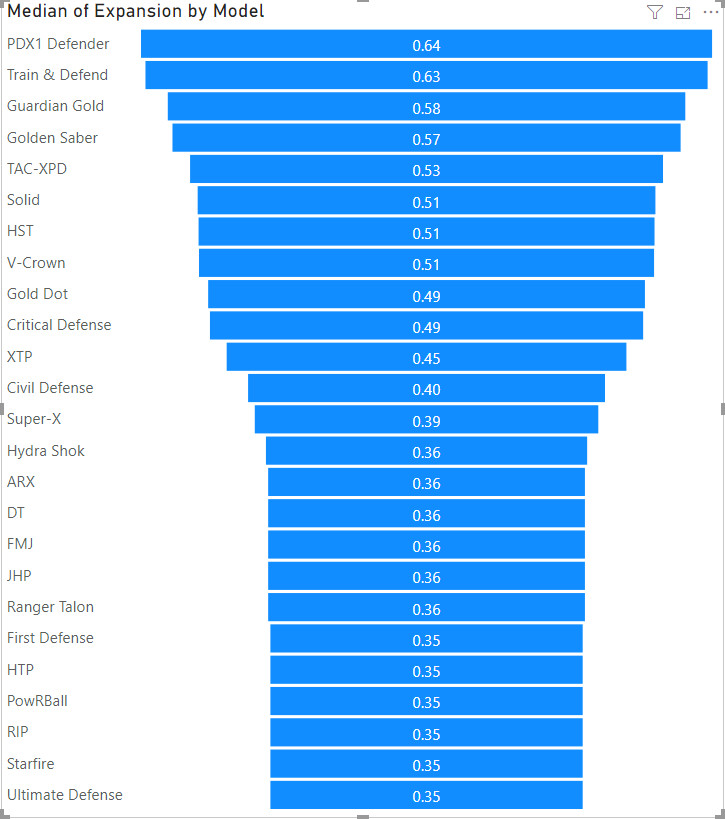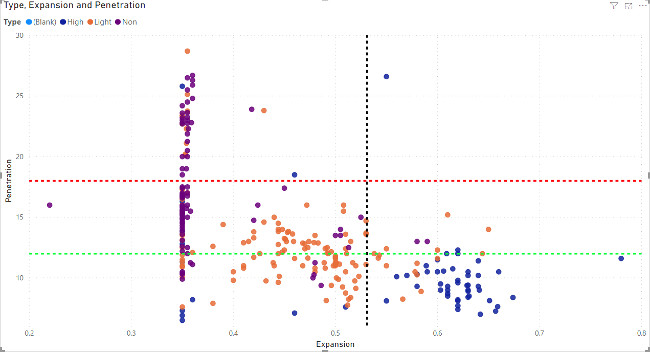Thanks, readers, for commentary on the intro (or, as one put it, lots of words to say nothing). Hopefully not nothing:
– This is about .380 not 9 or 40 or 45 because 380 is the sort-of-marginal caliber with respect to the FBI spec
– .380 is not a ‘duty’ caliber but we’re going to use the FBI spec as a useful benchmark, but only the bare/denim tests, not the barrier tests.
OK, so a bit about the data. Lots of sources from ammunition sellers to YouTube bloggers have done .380 tests, and of those I have only selected those that provided FPS and, ideally, penetration and expansion into organic or non-organic ballistic gel. That’s still over 330 data points of:
– Brand/Model/Weight(gr) of ammunition
– Tester, URL, and test date
– Firearm and barrel length
– Test condition (bare gel or 4 layers+gel)
– FPS, penetration, and expansion
Here I have to add a note. Many of the testers listed each round’s FPS/penetration/expansion, which is ideal for drawing analyses. Many sorted their 5-round groups by FPS, penetration, and expansion independently, so that while it’s good data we don’t know how they correlate. In this segment we’re going to see visualizations that don’t rely on making that connection; in the next one some linear analysis will attempt to fill in the correlation for us.
– From the grains and FPS I’ve calculated a power factor ((grains*FPS)/1000) partly to see if it’s possible to bring a .380 to “BUG” IDPA competitions.
A quick look at all of the rounds together for penetration and expansion clearly shows there are very different designs going on here:

I’ve put ideal lines in at 12″ and 18″ penetration and .531″ expanded size (50%, although I could’ve put it at .525 as the bullets start at .35″) to show what might be termed the ‘goldilocks zone’ for rounds; enough but not too much penetration, and full expansion. Not a lot in that zone between green and red and right of the black line!
What this led me to do immediately is classify the types or models of ammo into:
– Non-expanders (FMJ and things that act like that);
– Light expanders (ones that mostly don’t get bigger than .531″); and
– High expanders (the ones that do)
This required that I go back and slice up the data by model.

Just for those keeping score, the .35 and .36 ones are going under “non”; from there to the Copper-Only Solid are “light”; and beyond that “high.” An anomaly here; the Federal Hydra-Shok went under “non” as their median (out of 21 samples) was .36″ although the average was .42″; so what you’re seeing here are lots of rounds that didn’t expand, and a few that mushroomed out to .5 or better.
Also this chart just listed the model, but there are a few makers of rounds that are just called “JHP” so I labeled them appropriately without redoing the above chart. Same thing with several makers using the XTP bullet; but all of them came out in the “light” category.
Lastly, doing this reminded me of how many tests I’d collected that didn’t list expansion data. Those will have to wait until I test out a model to fill in the missing data from the FPS and penetration data; they’re blank for now.

OK, without even doing any math, or caring which firearm one is using, I can already draw some hypotheses:
– The .380 is still not a duty round! (But I just found a page that claims to have the rating scale for the FBI test, and it’s 70% penetration, 20% expansion, and 10% consistency; if I can verify that I’ll have some calculations with it)
– Like any other caliber, if you want to be sure of making a hole through something, use FMJ. There are a few ‘defense’ rounds which I will list at the end and act just like FMJ, so just buy FMJ. Just note you will probably make a hole through whatever’s behind your intended target too.
– The brands that expand massively almost never penetrate massively. Some get kinda close so when we get into firearms and barrels, some may pan out; we’ll see.
– The brands that are designed to expand lightly are most of the dots in the 12″ to 18″ range with some expansion, and nearly all the goldilocks rounds are those too. Again, much more clarity coming with firearms and barrels.
This went a different direction than I’d intended when starting to write. I’d planned on diving straight into barrel length and ended up adding features to the study and writing all about that instead. Part II.2 will proceed on course…